Just like Buddhist temples, Taoist temples, and Christian churches, Islam has its own dedicated places of worship, which are mosques.
There are countless mosques around the world, and those that are particularly large often have architectural, aesthetic, and historical significance. Even as an ordinary tourist, if you have the opportunity to visit these unique mosques, it will be a memorable travel experience.
10. Jama Mosque, Delhi (Capacity- 25000 People)
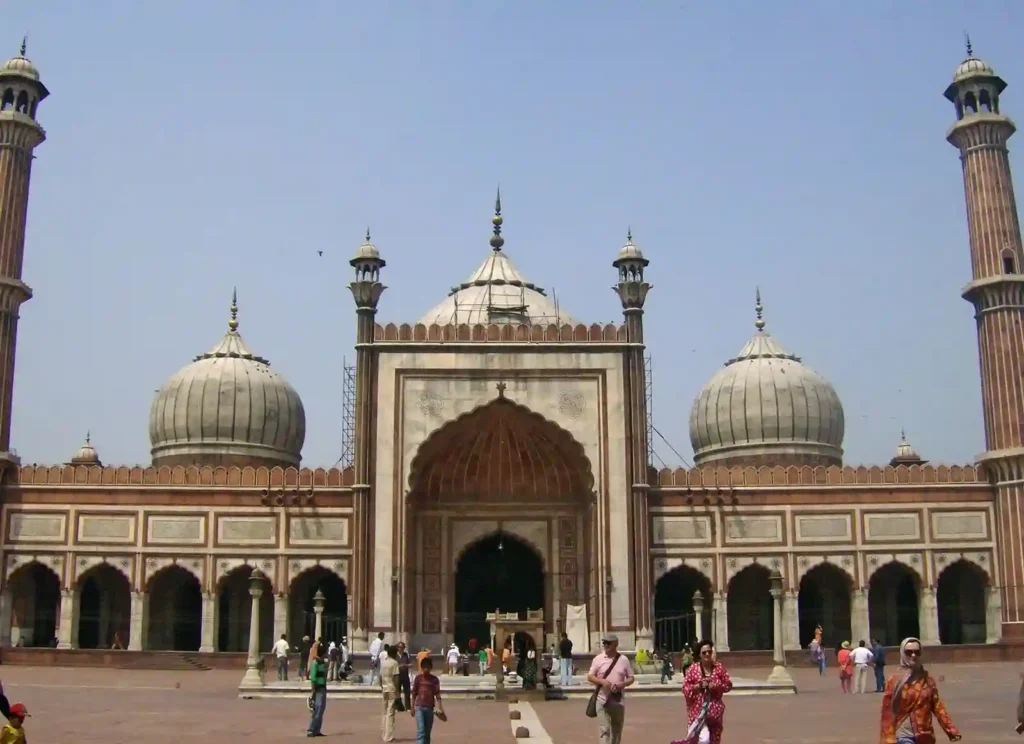
“Jama Mosque” near the Royal Palace of Delhi stands as the largest mosque in India – Jama Mosque, which is also a famous monument in Delhi. The Jama Masjid is located in the old city of Delhi and is the largest mosque in India. The courtyard in the mosque can accommodate 25,000 believers. The temple was built in 1644 and officially completed in 1658. It was the last architectural luxury of King Shah Jahan of India.
The mosque is ornately decorated, with three gates, four towers, and two 40-meter-high minarets. Tourists can rent religious clothing at the North Gate. For Muslims, the Jama Masjid is a must-see. Looking from a distance, the three curved white domes and two towering minarets are admirable for their majestic image and majestic momentum.
The construction of the Jama Mosque was inspired by the Great Mosque of Damascus. It was built on a grand scale, with a high plinth, a great vaulted portico rising in the middle, and equally imposing vaults with countless small vaults between them looming in the background. What is impressive is its enormous size and almost rigid austerity in its structure. The grand courtyard of the mosque is surrounded by broad colonnades. The arrangement of the arches, columns, and number of openings in the colonnade, and the rows of vaults above, are all varied and pleasing to the eye.
9. Sheikh Zayed Grand Mosque, Abu Dhabi (Capacity- 41000 People)
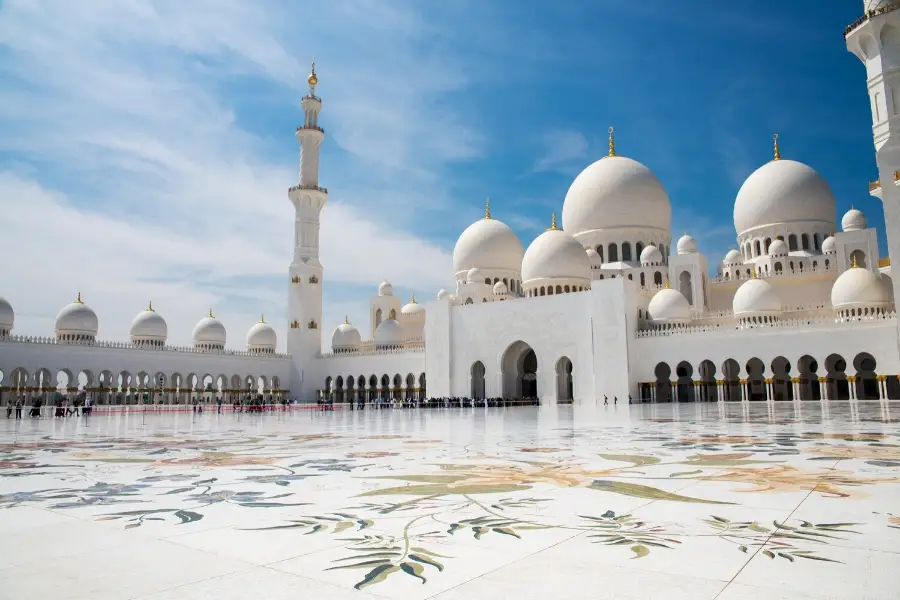
The planning of the city of Dubai in the United Arab Emirates is aimed at a world-class metropolis. This city, which rose from a piece of yellow sand, is now filled with buildings that seem to come from a science fiction world. Under the appearance of modernization, the UAE still sticks to its traditions, and the Sheikh Zayed Grand Mosque is a high embodiment of this tradition. The Grand Mosque started construction in 1996 and took 11 years to complete. It was named after Zayed bin Sultan Al Nahyan, the founding father of the United Arab Emirates.
There are as many as 82 large and small domes in this mosque. Its style absorbs the essence of Persian architecture and Mughal architecture and directly refers to the design of famous mosques such as Alexander Mosque and Badshahi Mosque. The main chapel is covered with the world’s largest handmade carpet and hangs the world’s largest chandelier. Zayed was also buried in this mosque after his death in 2004.
8. Bait ul Mukarram Mosque, Dhaka (Capacity- 42000 People)

The Baitul Mukarram Mosque is located in Guristan, downtown Dhaka. Founded in 1960, the Baitul Mukarram Mosque is the largest and can accommodate tens of thousands of people At the same time, the Mukalam Mosque is the largest mosque in Dhaka. It was built in 1960 after the Kaaba Hall in Mecca. Seen from a distance, its walls are towering, like a large white box placed on a high platform, standing in the air. The top floor of the temple is an open-air square with a clean ground, where Muslims can hold grand ceremonies.
The whole structure of the mosque is white, with a height of 6 floors and a unique style. There are many worship halls and halls in the temple, which can be used by 42000 people to worship at the same time. Seen from a distance, its walls are towering, like a large white box placed on a high platform, standing in the air. The top floor of the temple is an open-air square with a clean ground, where Muslims can hold grand ceremonies.
7. Badshahi Mosque, Lahore (Capacity- 70000 People)
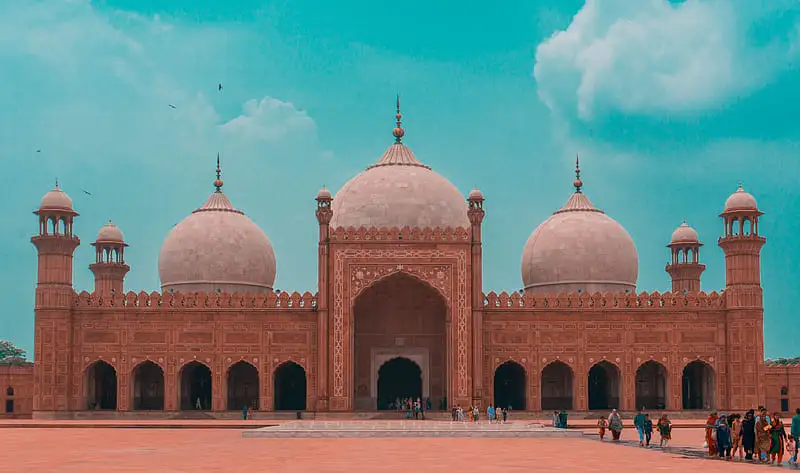
Aurangzeb was the last ruler of the Mughal Empire. He once unified almost the whole of India. In order to let future generations remember his achievements and the heyday of the empire, he decided to build a mosque. Aurangzeb’s father, Shah Jahan, is famous for a building, which is the Taj Mahal he built for his wife. Aurangzeb inherited his father’s preference for grand buildings. He built a larger and more luxurious mosque in Lahore based on the Jama Mosque built by Shah Jahan in Delhi.
The Badshahi Mosque is the epitome of Mughal architecture. The exterior is entirely made of red sandstone, and the three huge domes and the top of the octagonal minaret are made of marble. The courtyard of this mosque is the largest among all mosques in the world, and the open hall arch leading to the main building is also unique, and its design has been borrowed from many other famous mosques.
6. Faisal Mosque, Islamabad (Capacity-74000 People)

The Faisal Mosque is located in the northernmost part of Islamabad, the capital of Pakistan, backed by Mount Magra. It is the national mosque of Pakistan. The mosque is named in honor of King Faisal of Saudi Arabia, who generously funded a huge sum of $120 million before construction began in 1976. Unlike mosques in most Asian countries, the Faisal Mosque does not have any domes or arches. Its shape is inspired by the tents inhabited by the Arab Bedouins.
The main prayer hall is a huge triangle, and the minaret is built into a slender pencil It may have been influenced by Turkish architecture. The Faisal Mosque is one of the finest examples of contemporary Islamic architecture and one of Pakistan’s top tourist attractions.
5. Hassan II Mosque, Casablanca (Capacity-105000 People)
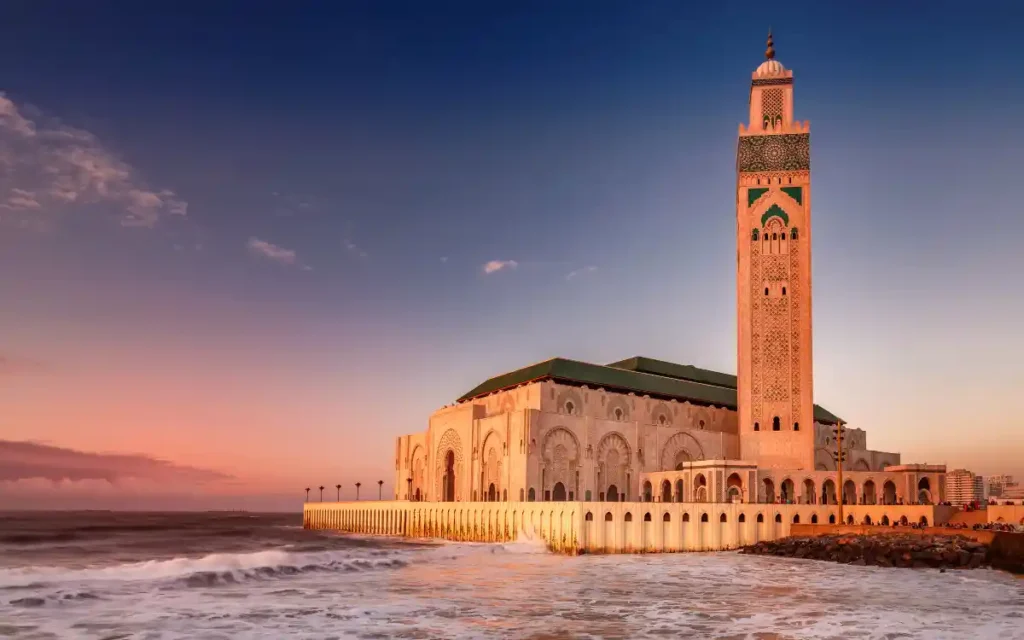
The former king of Morocco, Hassan II, wanted to leave something behind and let future generations remember himself, so the Hassan II Mosque was erected in Casablanca. This large building was completed in 1993 at a cost of 800 million U.S. dollars. It looks like a Moorish mosque from the outside. Inside the Hassan II Mosque, the best technology at that time was used. Electric doors and geothermal devices were installed. The roof of the chapel can be opened and closed electrically.
The top of the minaret is equipped with a laser pointing to the direction of the holy place of Mecca. The minaret of Hassan II Mosque is as high as 210 meters. You can see the sea under your feet, but this area is only available to members of the royal family.
4. Istiqlal Mosque, Jakarta (Capacity-120000 People)

Indonesia, with the world’s largest Muslim population, needed a huge national mosque as a matter of course, a dream that became a reality in 1978 under President Suharto’s administration. However, it was Suharto’s predecessor Sukarno who really paid the most for this mosque. As the leader of Indonesia’s independence, he not only fully supported the idea of building a national mosque, but later simply served as the technical director himself.
The mosque was named the Independence Mosque to commemorate Indonesia’s independence. Its architectural style is completely different from traditional mosques and closer to the public building style of the former Soviet Union. The main building of the independent mosque is rectangular, with 12 huge columns in the middle supporting a central dome with a diameter of 45 meters.
There is a smaller building next to the main building as the entrance of the main building. The surrounding arcades surround the courtyard in front of the Independence Mosque, and a minaret with a steel spire stands at a corner of the courtyard, forming the highest point of the entire mosque.
3. Imam Reza Shrine, Mashhad (Capacity-120000 People)
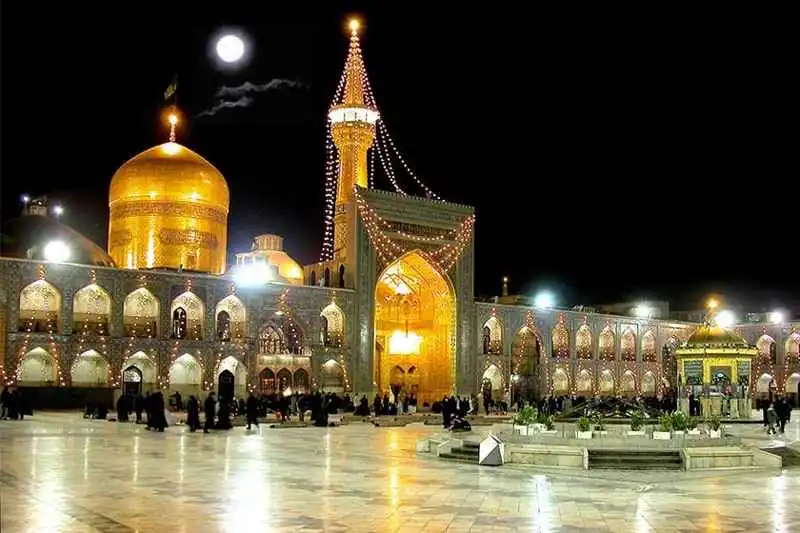
Imam Reza Shrine Mosque is one of the famous Shia mosques in Iran. The mosque is built over the tomb of Raza Imam, who was last alive in the 8th century. Hence Imam Raza is remembered with great reverence and his tomb is considered as an important site.
The 9th century saw the construction of this mosque, which has subsequently undergone several renovations. The mosque’s main structure is fairly sizable and has a wide variety of rooms.
In addition to this, this mosque contains a sizable mausoleum chamber that is home to Imam Raza’s grave. This mosque is popular as a tourist destination, and thousands of people go there each year. The crowd in this mosque is very high, but still, it is a unique experience to see it. Information about the life of Imam Raza is also available from local specialties here.
The Imam Raza Shrine Mosque is attached to a large mausoleum that houses the tomb of Imam Raza. There are many different buildings around this mausoleum which are set within this mosque.
Many facilities are available to the devotees visiting this mosque. There are also eateries here where devotees can come to eat. There is also a special aarti in this mosque at the time of morning prayer, in which one wishes to be free from particular trouble.
This mosque is regarded as a significant religious site in Iran and as one of the most significant religious sites in the entire globe. Apart from this, this mosque is not only visited by hordes of devotees but also by scientists and historians.
The size of the Imam Raza Shrine Mosque is huge. There is a total area of two hundred acres around this mosque and it has many different buildings. The mosque was built sometime before 300 AD and was later extended several times. Therefore, it is difficult to get an accurate idea of the size of this mosque.
It is difficult to overestimate the potential of the Imam Raza Shrine Mosque. This is a very big mosque and it has many big halls and namaz houses where many people can offer namaz at the same time. There are also special halls for big events and women in this mosque.
However, information is available about the capacity of some of the buildings associated with the hospital and kitchen of this mosque. The capacity of this mosque is around 700000 people.
2. Al Masjid an Nabawi, Medina (Capacity-1Milion People)
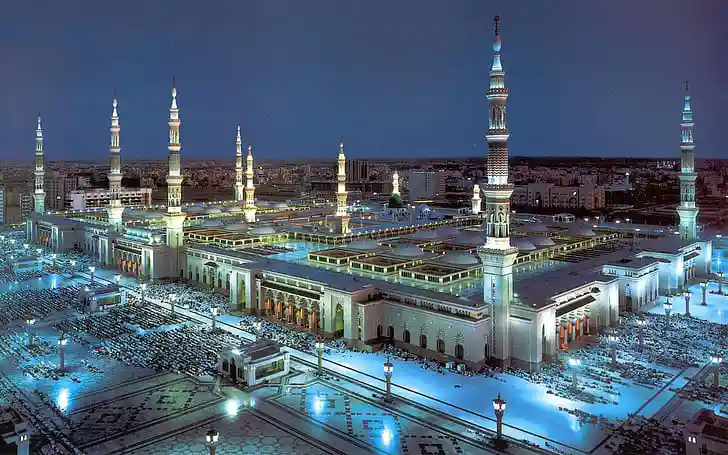
Any religious building can be as beautiful as possible, but the condition of sanctity cannot be achieved by human and financial resources. In this regard, the Prophet’s Mosque has a unique advantage. First of all, it was built by the Prophet Muhammad himself, and it is also his final resting place. Next to the original site of the Prophet’s Mosque is the residence of Muhammad after he moved from Mecca to Medina. He built the mosque next to his home so that he could handle various affairs at any time. In the nearly 1,400 years since it was built, the Prophet’s Mosque has been renovated many times, and its scale has become larger and larger.
Today it has become the second-largest mosque in the world. The green main dome is the prominent symbol of the Prophet’s Mosque. In addition, it has as many as ten minarets. The successive Saudi kings are the administrators of this sacred mosque in the name.
1. Al-Haram Mosque, Mecca (Capacity-2.5 Milion People)

Regardless of the past, present, and future, the supreme mosque in the Islamic world can only be the Masjid al-Haram, and it is also the largest mosque in the world. Every year, more than one million believers go to the Al-Haram for pilgrimage, because in Islamic belief, the Kaaba located in the center of the Al-Haram Square is the first man-made building on earth, built by the first human Adam, and built by Yi Jointly built by Brahim and Ismaili, the Prophet Muhammad removed 360 idols and murals and inlaid a sacred black stone in the southeast corner.
Today, when Muslims all over the world pray, they all face the direction of the Ka’ba, and they only pray around the Ka’ba when they come to the Mosque for Hajj. The Al-Haram has 25 gates and 9 tall minarets, which can accommodate 25,00,000 people to worship at the same time. It is well-deserved as the world’s largest mosque.






.png)
